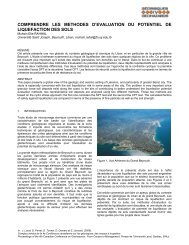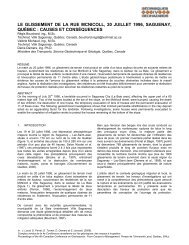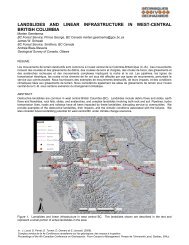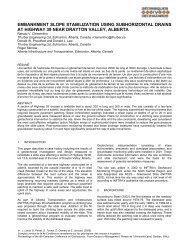Impact of global warming on stability of natural slopes
Impact of global warming on stability of natural slopes
Impact of global warming on stability of natural slopes
Create successful ePaper yourself
Turn your PDF publications into a flip-book with our unique Google optimized e-Paper software.
<str<strong>on</strong>g>Impact</str<strong>on</strong>g> <str<strong>on</strong>g>of</str<strong>on</strong>g> <str<strong>on</strong>g>global</str<strong>on</strong>g> <str<strong>on</strong>g>warming</str<strong>on</strong>g> <strong>on</strong> <strong>stability</strong> <str<strong>on</strong>g>of</str<strong>on</strong>g> <strong>natural</strong> <strong>slopes</strong><br />
These equati<strong>on</strong>s, however, <strong>on</strong>ly hold true for recently<br />
formed <strong>slopes</strong> which lack cohesi<strong>on</strong>. In reality, most <strong>natural</strong><br />
soil has an apparent cohesi<strong>on</strong>. Cohesi<strong>on</strong> is typically caused<br />
through cementati<strong>on</strong> or aging effects.<br />
For a slope formed with soil having a cohesive comp<strong>on</strong>ent<br />
soil the FOS increases due to the cohesi<strong>on</strong>:<br />
FOS = tan Φ’ + B (c’/γ H) [3]<br />
tan i<br />
When <strong>natural</strong> soil <strong>slopes</strong> have vegetati<strong>on</strong> cover, the roots<br />
serve as reinforcement and the FOS again increases.<br />
FOS = (available strength from soil + reinforcement) [6]<br />
required strength<br />
Mathematically this becomes:<br />
FOS = tan i + B (c 1 /γ H) [7]<br />
tan Φ’<br />
where the parameter B ranges between 1 and 6 depending<br />
up<strong>on</strong> the slope ratio, c’ is the apparent cohesi<strong>on</strong>, γ is the<br />
bulk unit weight <str<strong>on</strong>g>of</str<strong>on</strong>g> the soil and H is the thickness <str<strong>on</strong>g>of</str<strong>on</strong>g> the<br />
sliding mass. However, in the l<strong>on</strong>g term, for example as a<br />
result <str<strong>on</strong>g>of</str<strong>on</strong>g> desiccati<strong>on</strong>, stress relief or seas<strong>on</strong>al frost effects,<br />
many soils lose their cohesi<strong>on</strong> and the FOS equati<strong>on</strong> goes<br />
back to Equati<strong>on</strong> 1.<br />
When seepage forces are involved further below the slope<br />
surface, then the FOS <str<strong>on</strong>g>of</str<strong>on</strong>g> a slope with cohesi<strong>on</strong> is reduced<br />
by a lesser degree to the following equati<strong>on</strong> for seepage<br />
parallel to the slope:<br />
FOS = A tan Φ’ + B (c’/γ H) [4]<br />
tan i<br />
where A ranges between 0 to 1 depending up<strong>on</strong> r u values<br />
and the slope ratio, and where r u is the pore pressure ratio,<br />
a measure <str<strong>on</strong>g>of</str<strong>on</strong>g> the water table height within the slope.<br />
An apparent cohesi<strong>on</strong> can also result from soil (matric)<br />
sucti<strong>on</strong>. The latter applies to unsaturated soil, and varies<br />
with its degree <str<strong>on</strong>g>of</str<strong>on</strong>g> saturati<strong>on</strong> and the magnitude <str<strong>on</strong>g>of</str<strong>on</strong>g> the<br />
sucti<strong>on</strong>. Soil sucti<strong>on</strong> therefore provides additi<strong>on</strong>al strength,<br />
explaining why <strong>natural</strong> <strong>slopes</strong> appear stable even when the<br />
FOS calculated without an allowance for soil sucti<strong>on</strong> is less<br />
than unity. However, this additi<strong>on</strong>al strength is lost if the soil<br />
saturates, for example, during heavy rain. When soil<br />
sucti<strong>on</strong> is involved as a result <str<strong>on</strong>g>of</str<strong>on</strong>g> a partially saturated soil,<br />
the FOS increases following the equati<strong>on</strong> below by Fredlund<br />
and Rahardjo (1993):<br />
where c 1 c<strong>on</strong>sists <str<strong>on</strong>g>of</str<strong>on</strong>g> strength as a result <str<strong>on</strong>g>of</str<strong>on</strong>g> both soil<br />
cohesi<strong>on</strong> and root reinforcement.<br />
The soil cohesi<strong>on</strong> within the root z<strong>on</strong>e is usually n<strong>on</strong>existent<br />
due to weathering effects. The remaining cohesi<strong>on</strong> as a<br />
result <str<strong>on</strong>g>of</str<strong>on</strong>g> root reinforcement can be lost if the vegetati<strong>on</strong><br />
dies.<br />
4. IMPACT OF GLOBAL WARMING ON STABILITY OF<br />
NATURAL SLOPES<br />
Due to <str<strong>on</strong>g>global</str<strong>on</strong>g> <str<strong>on</strong>g>warming</str<strong>on</strong>g>, patterns <str<strong>on</strong>g>of</str<strong>on</strong>g> precipitati<strong>on</strong> and wind,<br />
type <str<strong>on</strong>g>of</str<strong>on</strong>g> vegetati<strong>on</strong>, average temperature and flooding will<br />
change. For <strong>natural</strong> soil <strong>slopes</strong>, these changes can result in<br />
the loss <str<strong>on</strong>g>of</str<strong>on</strong>g> certain resisting forces available and incur<br />
additi<strong>on</strong>al driving forces. Natural <strong>slopes</strong> normally have a<br />
FOS marginally above unity, with their slope angles<br />
representative <str<strong>on</strong>g>of</str<strong>on</strong>g> the most severe c<strong>on</strong>diti<strong>on</strong>s experienced in<br />
the past. Where the climate change effects reduce the<br />
FOS, landslides can result (Figure 3). Furthermore,<br />
landslide pr<strong>on</strong>e terrain becomes more susceptible to n<strong>on</strong><br />
climate change related triggers such as earthquakes.<br />
FOS = tan i + B (c/γ H) [5]<br />
tan Φ’<br />
where c is the total cohesi<strong>on</strong> which has two comp<strong>on</strong>ents;<br />
the apparent cohesi<strong>on</strong> c’ and the matric sucti<strong>on</strong> parameter<br />
(u a -u w )tanΦ b . In this case u a is pore air pressure, u w is pore<br />
water pressure and Φ b is the angle <str<strong>on</strong>g>of</str<strong>on</strong>g> fricti<strong>on</strong> with respect to<br />
changes in matric sucti<strong>on</strong>.<br />
However, when saturati<strong>on</strong> <str<strong>on</strong>g>of</str<strong>on</strong>g> the soil occurs, the matric<br />
sucti<strong>on</strong> disappears and the FOS equati<strong>on</strong> goes back to<br />
Equati<strong>on</strong> 1 or 4.<br />
Figure 3. Landslide at Pic River near Marath<strong>on</strong>, Ontario.<br />
Examples <str<strong>on</strong>g>of</str<strong>on</strong>g> climate change impacts <strong>on</strong> <strong>slopes</strong> include an<br />
infiltrati<strong>on</strong> increase causing loss <str<strong>on</strong>g>of</str<strong>on</strong>g> soil sucti<strong>on</strong>, a reducti<strong>on</strong><br />
in effective stress due to rising groundwater levels, a loss <str<strong>on</strong>g>of</str<strong>on</strong>g><br />
root reinforcement due to changes in the type <str<strong>on</strong>g>of</str<strong>on</strong>g> vegetati<strong>on</strong><br />
or dying <str<strong>on</strong>g>of</str<strong>on</strong>g> vegetati<strong>on</strong>, an increase in seepage forces due to<br />
frequent and intense storms, an increase in the frequency <str<strong>on</strong>g>of</str<strong>on</strong>g>







